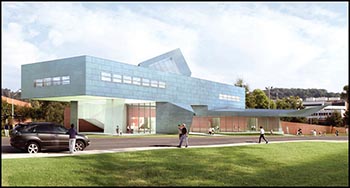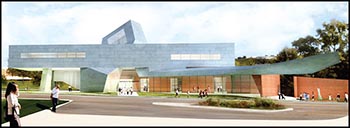Construction of the Abroms-Engel Institute for the Visual Arts is near completion, and soon the angular, two-story, zinc, glass and brick building will become home for University of Alabama at Birmingham Department of Art and Art History galleries, classrooms and faculty.
 View looking south-westCurious visitors and students who have walked by the building in progress, on the corner of 13th Street and 10th Avenue South, will be able to explore the 26,000-square-foot building in early 2014, when classes are expected to begin there, and an opening exhibit will be on show. Art history, time-based media and graphic design classes, along with administrative offices, will be housed within the building.
View looking south-westCurious visitors and students who have walked by the building in progress, on the corner of 13th Street and 10th Avenue South, will be able to explore the 26,000-square-foot building in early 2014, when classes are expected to begin there, and an opening exhibit will be on show. Art history, time-based media and graphic design classes, along with administrative offices, will be housed within the building.
The facility is named for lead donors Hal and Judy Abroms, as well as Ruth and the late Marvin Engel. The building was designed by Los Angeles-based architect Randall Stout, who worked with senior associate Frank Gehry for seven years. Hoar Construction oversaw the construction of the building. The completion of the AEIVA will create dynamic indoor and outdoor public spaces that physically and visually connect with the Alys Stephens Performing Arts Center across the street, said UAB President Ray L. Watts.
“We are excited to take this major stride in creating a vibrant nexus of arts and culture for UAB and our entire community,” Watts said. “With its striking architecture and state-of-the-art capacity to house important visual art works and educate students of art and art history, the Abroms-Engel IVA will be an invaluable addition to UAB’s cultural corridor, complementing the Alys Stephens Performing Arts Center, the William Hansell and Susan Mabry Hulsey Center for Arts and Humanities and the National Alumni Society House. This campus and community can look forward to enjoying world-class exhibitions and cultural events in this marvelous new facility for years to come.”
The AEIVA will attract the best students and faculty to study at UAB, said College of Arts and Sciences Dean Robert Palazzo, Ph.D.
 View looking south“The Abroms-Engel Institute for the Visual Arts will not only serve students, but the public as well, and it will be a regional and national destination for those seeking to experience world-class art,” Palazzo said. “As the Alys Stephens Center has provided the premier venue for cultural entertainment, the IVA will provide that type of venue for fine art, all on the campus of a Carnegie-rated Research University.”
View looking south“The Abroms-Engel Institute for the Visual Arts will not only serve students, but the public as well, and it will be a regional and national destination for those seeking to experience world-class art,” Palazzo said. “As the Alys Stephens Center has provided the premier venue for cultural entertainment, the IVA will provide that type of venue for fine art, all on the campus of a Carnegie-rated Research University.”
Three gallery spaces are included for regularly changing exhibitions of art, including student, faculty and alumni shows. Classrooms, studio laboratories and administrative offices will enhance teaching and learning. The building will boast an outdoor sculpture garden, covered art plaza and exterior spaces for gathering. Pedestrian pathways will enhance the building’s grounds and connect with the arts and culture district. The main lobby has a two-story atrium that will allow natural light to flood the lobby below and provide views between second floor academic spaces and ground floor public access. The glass-enclosed main lobby also will provide views into and out of the facility. The art plaza, an extension of the main lobby, is designed to support events from catered dinners to performances. New parking areas have been designed in the surrounding lot to ensure abundant parking.
“By clustering the arts disciplines into a centralized arts district, UAB intends to foster collaboration and a sense of community both within the university and in our community,” said Shirley Salloway Kahn, Ph.D., UAB vice president for development, alumni and external relations. “The Alys Stephens Center, the Hulsey Center and the new Abroms-Engel Institute for the Visual Arts are the perfect complement of entities to showcase the university’s commitment to arts education, cultural programming and community enrichment.”
Works from UAB’s permanent collection will be housed in the AEIVA, which will have state-of-the-art security and environmental control systems for humidity, temperature and UV exposure, as well as a loading/unloading bay within the building so works are always climate-controlled. Works in the permanent collection include Polaroids by Andy Warhol; a Pablo Picasso lithograph; six large James Rosenquist lithographs; eight Donald Judd etchings; large-format Polaroids, particularly those by William Christenberry; Christo’s “Mein Kölner Dom, Wrapped”; an Anthony Caro paper sculpture; a mural by Dzine; and a painting by James Marshall, aka Dalek. The new space will allow the works to be stored and displayed safely and securely, said Department of Art and Art History Chair Lauren Lake, M.F.A.
“The ability to properly house and exhibit our collection will allow us to be more sought-after for donors and more selective in terms of accessions and loan opportunities,” Lake said. “The quality of our collection puts us on the map, as UAB will be one of only a handful of exhibition spaces in the South outside of museums with the environmental standards to acquire and exhibit work by important contemporary and historic artists.”
The building’s material palette is based on red brick, glass and patinaed zinc. An education bar, light monitor and elevator cube on the north side of the main public entrance, and a canopy over the gallery concourse, are clad in the zinc, which creates a durable, lightweight and high-performance envelope that enables and emphasizes the building’s dramatic sculptural shapes and cantilevers. The building is recognizable as one of 21st century technology, while blending with the predominant brick palette of the campus.